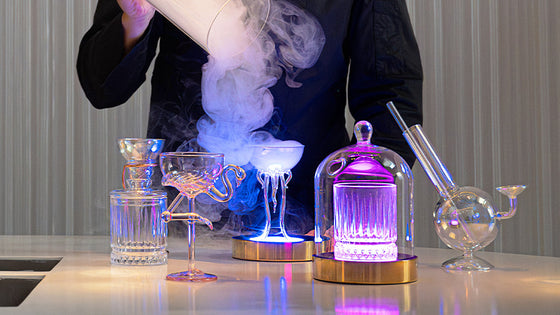Now our season of Olympic sport is over, we’re feeling a little nostalgia for Japan and the countries’ culinary delights. So we’ve compiled a list of our favourite, if a little unusual, Japanese ingredients to try in your cocktail recipes.
1. Yuzu
The Japanese fetishise fruit. As Japan is 80% mountain, the farmland available for fruit is rare, and growing small crops is often a family-run, labour-intensive business with high associated costs.
So a hybrid homegrown citrus whose juice, peel, and seeds are all usable in luxury vinegars, seasonings, sauces, marmalades, cosmetics, perfume, and aromatherapy is a Godsend. Indigenous to China, but easily grown on the island of Shikoku in Japan, Yuzu is sharp and highly acidic, but good for heart health, reducing inflammation and packed with antioxidants.
Despite not having a considerable amount of pulp, and therefore juice, Yuzu is used in various cocktails. But it takes only a little to go a long way. The yuzu tang is naturally suited to sours recipes, however, you can also use the fragrant oil for infusions and garnishes.
2. Matcha
Matcha powder comes from finely ground green tea leaves. The leaves set aside for matcha are from bushes grown in the shade for three to four weeks to increase the levels of theanine and caffeine. It's typically used in a traditional Japanese tea ceremony, but it's also mixed with water or milk on its own, or to flavour wagashi — traditional sweets — noodles, coffee, ice cream, chocolate and a type of tempura called matcha-jio.
There are various grades of matcha. One way of grading it is to look at the quality of the tea tree it comes from. The high-quality powder is called ceremony grade, as it's used for tea, mid-range is called premium grade, and lower quality is referred to as culinary grade.
High quality, ceremony grade matcha can be named after a plantation, shop, blender, or by the grandmaster of a particular tea tradition. If a specific blend is handed down through generations of apprentices, making a lineage, it's called the master's Konomi.
Matcha has high caffeine levels but conversely stress-reducing effects. It also has small amounts of epigallocatechin gallate and catechin; two acids thought to aid weight loss and help fight cancer. It works well with all sorts of liquids as a fresh ingredient or infusion.

3. Sake
Sake pronounced SAH-kee, is known as a rice wine, but it's fermented more like beer in that the alcohol produced comes from starch rather than fructose. Rice is polished to remove the outer shell, called the bran, and fermented between 18-20 % ABV. It is often diluted to a bottling strength of around 15% ABV.
The Japanese language character for sake means any alcoholic drink. So traditional sake is labelled 'seishu', meaning refined alcohol. The first mention of sake is in Japan's earliest written history, compiled in 712, and from 794, its thought to have been used in traditional drinking ceremonies. Nowadays, it's often presented in a ceramic flask, warmed (depending on the type of sake) and served in a small ceramic cup called a sakazuki.
Sake has been used in modern cocktails for decades, and there are plenty of recipes to try out before you experiment with your creations.
4. Tofu
Tofu is made by separating soy milk then compressing the curds into blocks of varying softness; either silken, soft, firm, extra firm or super firm. The thickening process separates the oil and water from the proteins in the beans, which means tofu is very light on calories and high in protein.
Some clever scientists in Singapore are using the waste from tofu production to make alcohol, but the most replicable use of tofu in Japanese drinks is the tofu milkshake. Usually, a mixture of silken tofu, soy milk, ice and flavouring agents, the result is an intensely creamy, healthy, vegan shake option.
5. Midori
Suntory released Hermes Melon Liqueur in 1964, but in 1978 the company changed its name to Midori, a word meaning green in Japanese, for the US release at Studio 54 in New York at the cast party for Saturday Night Fever. The melon-flavoured liqueur was made exclusively in Japan until 1987 and had an intense sweetness to match the emerald colour.
Midori is made from fresh & real fruit. In Yubari City, they make a pulp from yubari and muskmelons harvested in June and July. This pulp is frozen straightaway to harness the flavour and delivered to Suntory, where it is completely defrosted being used to create both an infusion and a distillate. This distillate is blended with sugar and Louis Royer two-year-old cognac and natural green food colouring. Most of this blending happens in either France or Mexico, where the product is bottled at 20% for either the European or US market.
Midori Melon Liqueur was the main ingredient in 'The Universe,' the first prize cocktail in the United States Bartenders' Guild annual competition in 1978. Thanks to the balanced shape of the bottle, Midori was loved by flair bartenders, and these two influences made sure Midori featured on many back bars through the 80s and 90s. Drinks like the Midori Sour, the Japanese Slipper and the June Bug dominated cocktail lists with their sweet taste and riotous colours.
As most things do, Midori made a comeback in the mid naughties after bartender feedback saw Suntory significantly reduce the sugar content. It's now used as a base or modifier in many modern cocktails and paired with more unusual flavours.
6. Japanese Whisky
Several companies are producing whisky in Japan, but the two best-known and most widely available are Suntory and Nikka.
Shinjiro Torii was initially a pharmaceutical wholesaler who founded Kotobukiya Co., which later become Suntory. His life's work was to make Japanese whisky for Japanese people, so he built Japan's first whisky distillery in Yamazaki, a suburb of Kyoto, an area famous for its excellent water quality. Torii hired Masataka Taketsuru as a distillery executive after he studied distilling in Speyside and Campbeltown in Scotland and brought this knowledge back to Japan in the early 1920s. He played a crucial part in helping Torii establish the Yamazaki Distillery. In 1934 he left to form his own company—Dainipponkaju—which would later change its name to Nikka. In this new venture, he established the Yoichi distillery in Hokkaidō. Until 2000, Japanese whisky was a domestic product. The global community took notice and begun importing after Nikka's ten-year-old single malt won Best of the Best in Whiskey Magazine's internationally renowned awards.
Suntory is admired for its impressive mix of stills, whereas Nikka uses different yeast strains and varies its fermentation times to create different flavours. There is a revival in Japanese oak for maturing, which gives the whisky a distinctive incense-like aroma. Now there are more than ten distilleries on the island, so there's a cornucopia of single malts, blended malts, special bottlings and limited editions to try.
7. Shichimi Togarishi
This seven-ingredient condiment is often shortened to shichimi in Western shops, a blend of ground chilli peppers, ginger, seeds, and roasted citrus peel. It dates back to the 17th century when it was produced by herb dealers in Edo (current day Tokyo) and has a complexity that works in soups, sauces, noodles, and seasoning for rice crackers and bar snacks.
As the powder suspends in liquid and the seeds get in customer’s teeth, shichimi works best for infusions, syrups, cordial, or mixed with salt for glass-rimmed serves.
8. Mirin
Mirin is an unctuous, lustres liquor made from glutenous rice used as an essential cooking ingredient in Japanese cuisine. But before becoming a standard ingredient in the kitchen, the sweet liquor was valued as an opulent drink during Japan’s Edo Period (1603-1868). Mirin grew in popularity as fermentation techniques advanced during the 1800s but the category was eventually transcended by sake.
These days, mirin seldom makes it onto the spirits list. And beware of supermarket imitations. Culinary mirins sometimes have salt added to avoid the tax laws for importing alcohol. Sometimes they are simply mirin-like copycats made from glucose syrup. However, in Japan, the real deal, hon mirin (true mirin), can be served like a dessert wine in speciality bars and restaurants. And now producers like the Sumiya Bunjiro Brewery and the Ogasawara Mirin Brewery are handcrafting mirin as it was during the Edo Period.
Hon-mirin has 40 to 50 per cent residual sugar and 14 per cent ABV. Traditional producers start by making shōchū liquor, distilled from an alcoholic mash of water, rice and kōji (the fermentation enzyme used in sake, miso and soy sauce). This shōchū forms the base of a second mash, to which sticky steamed rice is added. The second mash is left to ferment for up to three months before being pressed and left to mature in tanks.
Use as you would Madeira wines, sherry or white port; with some caution and careful measurements, mirin will give depth of flavour and a silken texture to your drinks.

Please let us know if you use any of these ingredients in your cocktails, by sharing your posts and tagging us on Instagram and Facebook!
Also Read: Japanese Classic Cocktails
















